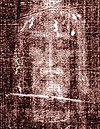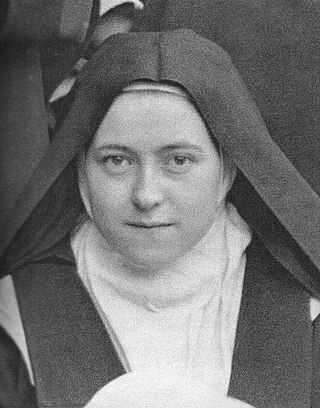
Thérèse of Lisieux, born Marie Françoise-Thérèse Martin, also known as Saint Therese of the Child Jesus and the Holy Face, was a French Catholic Discalced Carmelite nun who is widely venerated in modern times. She is popularly known in English as the Little Flower of Jesus, or simply the Little Flower, and in French as la petite Thérèse.

The scapular is a Western Christian garment suspended from the shoulders. There are two types of scapulars, the monastic and devotional scapular, although both forms may simply be referred to as "scapular". As an object of popular piety, it serves to remind the wearers of their commitment to live a Christian life.

The Scapular of Our Lady of Mount Carmel belongs to the habit of both the Carmelite Order and the Discalced Carmelite Order, both of which have Our Lady of Mount Carmel as their patroness. In its small form, it is widely popular within the Latin Church of the Catholic Church as a religious article and has probably served as the prototype of all the other devotional scapulars. The liturgical feast day of Our Lady of Mount Carmel, July 16, is popularly associated with the devotion of the Scapular.
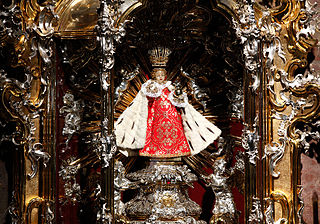
The Christ Child, also known as Divine Infant, Baby Jesus, Infant Jesus, the Divine Child, Child Jesus, the Holy Child, Santo Niño, and to some as Señor Noemi refers to Jesus Christ from his nativity to age 12.

Eucharistic adoration is a Eucharistic devotional practice primarily in Western Catholicism, but also to a lesser extent in certain Lutheran and Anglican traditions, in which the Blessed Sacrament is adored by the faithful. This practice may occur either when the Eucharist is exposed, or when it is not publicly viewable because it is reserved in a place such as a church tabernacle.

The Infant Jesus of Prague is a 16th-century wax-coated wooden statue of the Child Jesus holding a globus cruciger of Spanish origin, now located in the Discalced Carmelite Church of Our Lady of Victories in Malá Strana, Prague, Czech Republic. First appearing in 1556, pious legends claim that the statue once belonged to Teresa of Ávila and was consequently donated to the Carmelite friars by Princess Polyxena of Lobkowicz in 1628.
The Confraternity of the Holy Rosary is a Roman Catholic Archconfraternity or spiritual association, under the care and guidance of the Dominican Order. The members of the confraternity strive to pray the entire Holy Rosary weekly.

The Holy Face of Jesus is a title for specific images which some Catholics believe to be miraculously formed representations of the face of Jesus Christ. The image obtained from the Shroud of Turin is associated with a specific medal worn by some Roman Catholics and is also one of the Catholic devotions to Christ.
Mary of Saint Peter was a Discalced Carmelite nun who lived in Tours, France. She is best known for starting the devotion to the Holy Face of Jesus which is now one of the approved Catholic devotions and for the Golden Arrow Prayer. She also introduced the "Little Sachet" sacramental.
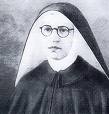
Blessed Maria Pierina De Micheli was a Roman Catholic religious Sister who was born near Milan in Italy. She is best known for her association with the Holy Face of Jesus and for introducing a medal bearing an image from the Shroud of Turin as part of this devotion.

Venerable Leo Dupont, also known as "The Holy Man of Tours," or the "Apostle of the Holy Face", was a Catholic who helped spread various Catholic devotions such as that of the Holy Face of Jesus and nightly Eucharistic Adoration. He was declared Venerable by Pope Pius XII.

Charles Théodore Colet was a French Roman Catholic Archbishop.

Reparation is a theological concept closely connected with those of atonement and satisfaction. In ascetical theology, reparation is the making of amends for insults given to God through sin, either one's own or another's. The response of man is to be reparation through adoration, prayer, and sacrifice. In Roman Catholic tradition, an act of reparation is a prayer or devotion with the intent to expiate the "sins of others", e.g. for the repair of the sin of blasphemy, the sufferings of Jesus Christ or as Acts of Reparation to the Virgin Mary.

Catholic tradition includes specific prayers and devotions as acts of reparation for insults and blasphemies against Jesus Christ and the Holy Name of Jesus. These include the sufferings during the Passion of Jesus. Similar prayers as Acts of Reparation to the Virgin Mary and Acts of Reparation to The Holy Trinity also exist.
The Pontifical Congregation of the Benedictine Sisters of the Reparation of the Holy Face is a Roman Catholic order whose focus is providing Acts of Reparation to Jesus Christ.
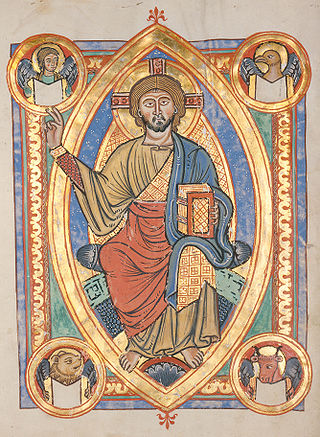
The Roman Catholic tradition includes a number of devotions to Jesus Christ. Like all Catholic devotions, these prayer forms are not part of the official public liturgy of the Church but are based on the popular spiritual practices of Roman Catholics. Many are officially approved by the Holy See as suitable for spiritual growth but not necessary for salvation.
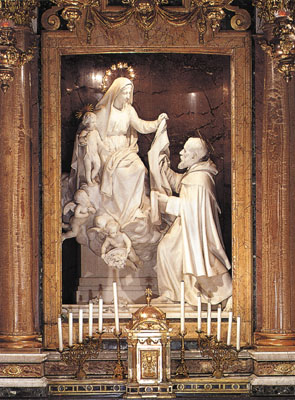
The exact origins of both the rosary and scapular are subject to debate among scholars. Pious tradition maintains that both the rosary and the brown Scapular of Our Lady of Mount Carmel were given by the Virgin Mary to Dominic and Simon Stock respectively during the 13th century. Historical records document their growth during the 16th and 17th centuries in Europe. By the early 20th century, they had gained such a strong following among Catholics worldwide that Josef Hilgers, writing in the Catholic Encyclopedia of 1914, stated: "Like the Rosary, the Brown scapular has become the badge of the devout Catholic."
The Archconfraternity of the Holy Face was established in Tours, France in 1876, by Archbishop Charles Colet; and raised to an Archconfraternity by Pope Leo XIII in 1885.

The National Shrine & Museum of St. Therese in Darien, Illinois is a Roman Catholic shrine dedicated to St. Thérèse of the Child Jesus and the Holy Face. The Shrine is a part of the Aylesford Carmelite campus, run by the Carmelite Order, Province of the Most Pure Heart of Mary. The National Shrine & Museum of St. Therese is supported and served by the Society of the Little Flower, a religious organization dedicated to promoting devotion to St. Therese of Lisieux.

Louis Martin and Azélie-Marie ("Zélie") Guérin Martin were a French Roman Catholic couple and the parents of five nuns, including Thérèse of Lisieux, a Carmelite nun who was canonized as a saint of the Catholic Church in 1925 and Léonie Martin declared "Servant of God" in 2015. In 2015, the couple were also canonized as saints, becoming the first spouses in the church's history to be canonized as a couple.
